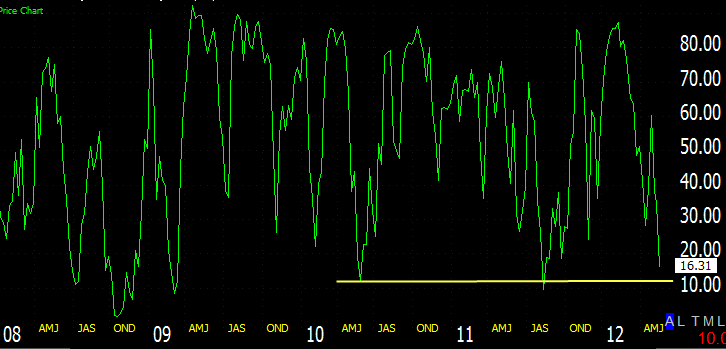The weekly chart below shows the percentage of stocks in the U.S. stock markets currently trading above their respective 40-day moving averages (this is a built-in indicator on the Telechart 2000 platform). As indicated in the graph, the percentage of stocks trading above their 40-day MAs is nearing the extreme 8-12% level, which we have seen during two major selloffs since the beginning of 2010 (represented by the yellow horizontal line).
This indicator is NOT used for market timing, as the indicator usually leads a market bottom by several weeks or more. Nevertheless, it does a good job of defining where the broad market is in terms of overall breadth. Once the market reaches an extreme level such as this, it can then begin to repair itself over the next few months:

Along with indicator above, both the NYSE and Nasdaq McClellan Oscillator are in deeply “oversold” territory. Furthermore, the major indices are now trading at or near major long-term support of their respective 200-day moving averages. Like the indicator shown on the chart above, the McClellan Oscillator is NOT used by our trading strategy as a market timing tool. Nevertheless, with many indicators and stocks at extremely “oversold” levels in the near-term, astute traders should be prepared for a swift reversal (counter-trend bounce) to the upside.
Until the inevitable broad market bounce eventually comes, we plan to avoid entries into new short positions. Further, since stocks are now in an established downtrend, we are not inclined to play the long side of the market either. Whether the forthcoming bounce will lead to quality short setups on stocks and ETFs that rally into resistance is impossible to know, but that is why we take the market one day at a time and shy away from bold predictions. We only need to know one thing right now: as long as our proven market timing model remains in a “sell” signal, we will be looking to establish new short positions into strength when the major indices bounce.
Finally, now is the perfect time to be patient in the market, especially considering the string of nice winning trades our Wagner Daily stock newsletter has had on the short side of the market over the past week. Opening new trades at the current levels involves taking on too much risk with minimal upside potential (negative reward-risk ratio). Nevertheless, select currency ETFs such as $EUO or commodity ETFs like $DZZ (both pointed out as potential pullback entries in the May 21 issue of our newsletter) could be nice plays because they have a low correlation to the direction of the overall equities markets. Otherwise, cash is king and a very valid position.
